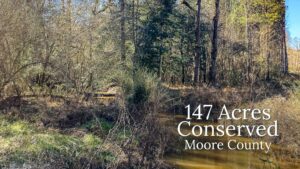
By: Crystal Cockman

With deer season over, many hunters may find themselves wondering what to do with all their spare time. Fortunately there are several other species that are still in season, including gray squirrel, woodcock, rabbit, and quail. One great spot nearby to hunt all of these species is the Sandhills Game Lands (SGL). If you’ve never been to the Sandhills Game Lands, you are missing out. This extensive conservation area is one of the largest publicly accessible and best examples of a longleaf pine forest preserve in existence.
Located in the southern coastal plain in portions of Moore, Richmond, Hoke and Scotland Counties, the Sandhills Game Lands comprise just over 60,000 acres of land. The SGL are owned and managed by the North Carolina Wildlife Resources Commission. The public range is open for hunting on Mondays, Wednesdays and Saturdays. The primary purpose of Sandhills Game Land is “to conserve and manage rare habitats and provide wildlife-related recreational opportunities to the citizens of North Carolina.” Some of the many ways the SGL is used by the public include hunting, fishing, trapping, wildlife viewing and photography, field trials, and horseback riding. They are also used for military training, research and education.
To hunt on the Sandhills Game Lands, a game lands license is required in addition to a regular hunting license, although this is included in some lifetime and sportsman’s licenses. There are also special restrictions and different open and closing dates for specific species on individual game lands, so you will need to consult your regulations digest or visit www.ncwildlife.org to ensure you follow all hunting regulations on a given game lands area.
In addition to game species, the well-managed Sandhills Game Lands are home to a variety of unique and rare nongame species, including red-cockaded woodpecker, Bachman’s sparrow, gopher frog, and tiger salamander. Longleaf pine forests are a dynamic ecosystem that requires fire to maintain, and active management by wildlife and forestry professionals is responsible for the high quality habitat found here.

There is a new game land management plan for the Sandhills Game Lands under development and consideration, though the public comment period ended January 16th. You can learn more and download a copy of this draft plan at http://www.ncwildlife.org/Portals/0/Hunting/Game-Land-Plans/Sandhills-GLMP-DRAFT-2RS.pdf.
Whether you want to take dogs out to hunt rabbit, squirrel, or quail, go for a horseback ride, or just enjoy a walk through a beautiful open canopy longleaf pine forest, the Sandhills Game Lands are an excellent nearby choice for an outdoor experience with friends.


